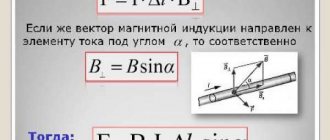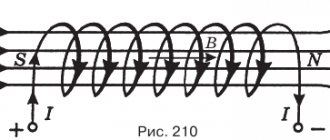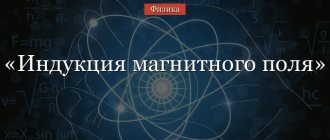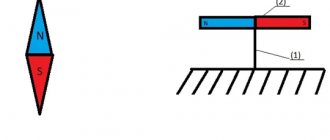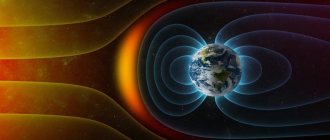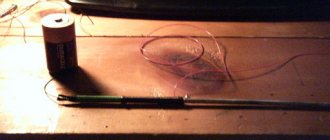According to historical chronicles, magnetic properties have been known and used by people for a very long time. In 1100 BC. e. Ancient travelers already used a compass. The appearance of the word “magnet” is associated with the name of the area Magnesia in Greece. The area is notable for the fact that there is a mountain there that attracts lightning during a thunderstorm. There is also such a mountain in the Urals - Magnitnaya. It consists almost entirely of magnetite.
The ability of iron to attract has been known to people for thousands of years. In addition to attraction, the fact of repulsion of objects from each other was also known. For example, a magnet repels copper. In ancient times it was also noticed that one side of a magnet attracts iron, and the other repels it. A scientific explanation of the causes of all these phenomena was not immediately given.
Historical reference
The history of magnetism goes back to ancient times, to the ancient civilizations of Asia Minor. It was on the territory of Asia Minor, in Magnesia, that rocks were found, samples of which were attracted to each other. Based on the name of the area, such samples began to be called “magnets”.
And another 2600 BC. Chinese Emperor Hwang Ti led his army in thick fog with the help of a magnetic figurine that, turning around its axis, always looked south. This, as you might guess, was a kind of prototype of the first compass. Already from the second century AD. In China, permanent magnets were manufactured that retained magnetic properties for a long time. And in the 13th century they learned about magnets and the compass in Europe.
Figure 1. First compass
The first scientific study of the properties of a magnet was undertaken in the 13th century by the French scientist Peter Peregrin. In 1269, his work “The Book of the Magnet” was published, where he wrote about many facts of magnetism: that a magnet has two poles, which the scientist later called north and south, and that it is impossible to separate the poles from each other by breaking . Peregrine also wrote about two types of interaction between poles - attraction and repulsion.
Figure 2. Interaction of two magnets
And in 1600, the essay “On the Magnet” by the English court physician and physicist William Gilbert was published. To the already known facts, Gilbert added such important observations as: strengthening the action of magnetic poles by iron reinforcement, loss of magnetism when heated, and others.
Figure 3. William Gilbert
However, it was only in the 19th century that the connection between electricity and magnetism was discovered, and the idea of a magnetic field arose.
In 1820, the Danish physicist Hans Christian Oersted (1777-1851) discovered that a magnetic needle located next to an electrical conductor is deflected when current flows through the conductor, i.e., a magnetic field is created around the current-carrying conductor.
His experience was of great importance for the development of the doctrine of electromagnetic phenomena.
Figure 4. Oersted's experiment
And having learned about Oersted's work, the French physicist Andre Marie Ampere studied the interaction of parallel conductors with current. He established that if there are multidirectional currents in conductors, the conductors repel each other. And if the currents have the same direction, then the conductors will attract.
Figure 5. Ampere's experiment
These were the two most famous experiments in the history of magnetic field research, which prompted other scientists to do more and more research in this area.
The concept of a magnetic field
A magnetic field is a special type of matter through which interaction occurs between moving electrically charged particles.
Figure 6. Magnetic field
The sources of the magnetic field are permanent magnets and current-carrying conductors. A magnetic field can be detected by the effect on a magnetic needle, a current-carrying conductor, and moving charged particles.
Figure 7. Effect of a magnetic field on a magnetic needle
Properties of magnetic field:
- the magnetic field is created by moving charged particles and bodies, current-carrying conductors, permanent magnets;
- the magnetic field acts on moving charged particles and bodies, on current-carrying conductors, on permanent magnets, on a current-carrying frame;
- the magnetic field is vortex, i.e. its lines of force (lines of magnetic induction) are closed.
Now I will talk about two forces acting in a magnetic field:
1. Ampere power
The Ampere force is the force that acts on a current-carrying conductor in a magnetic field.
There is also a special law about this force, called Ampere’s law: a conductor with a current of strength I and length l, placed in a magnetic field with induction B⃗ , is acted upon by a force whose modulus is equal to (the product of the current strength and the magnetic induction vector and to sine alpha):
F = IBlsin a
where α is the angle between the current-carrying conductor and the magnetic induction vector B⃗ .
The direction of the Ampere force is determined by the left hand rule : if the palm of the left hand is positioned so that the component of the magnetic induction vector B⊥ perpendicular to the conductor enters the palm, and four extended fingers indicate the direction of the current in the conductor, then the thumb bent 90° will show direction of the Ampere force.
Figure 9. Ampere force
2. Lorentz force
The Lorentz force is a force acting on a moving charged particle from a magnetic field.
Formula for finding the Lorentz force:
F = q* B * V * siin a,
where q is the particle charge, v is the particle velocity, B is the magnitude of the magnetic induction vector, α is the angle between the particle velocity vector and the magnetic induction vector.
The direction of the Lorentz force is determined by the left hand rule: if the palm of the left hand is positioned so that the component of the magnetic induction vector B⊥ perpendicular to the conductor enters the palm, and four extended fingers indicate the direction of the velocity of a positively charged particle, then the thumb bent 90° will show the direction of the Lorentz force.
Figure 10. Lorentz force
Ampere and Lorentz forces are widely used in science and technology. We'll look at this now.
Cyclotrons and synchrotrons
A cyclotron is a type of accelerator where particles with charges are accelerated from the center outward along spiral paths. A static magnetic field maintains a spiral trajectory, and accelerations are set by a rapidly changing electric field.
The particle is accelerated in the cyclotron and ejected through the beam
To accelerate beams of charged particles, cyclotrons use high-frequency alternating voltage between two D-shaped electrodes. An additional static magnetic field acts perpendicular to the electrode plane, causing particles to constantly collide. Therefore, the voltage frequency must converge with the cyclotron resonance frequency of the particle:
The frequency is determined by the equality of the centripetal and magnetic Lorentz forces. Particles introduced closer to the center increase their kinetic energy and therefore move along a spiral path. The radius will also increase until they hit the target of the vacuum chamber or fly out of the device. Such accelerated particles can be used to treat certain types of cancer.
A synchrotron is an improved version of a cyclotron, where the guiding magnetic field is based on time and synchronized with the particle beam and the increase in kinetic energy. This is one of the first accelerator concepts that can be used to create large-scale objects.
Application of a magnetic field. Ampere power
Ammeter
Another discovery of Ampere is the law of the action of a magnetic field on a current-carrying conductor. It is expressed primarily in the action of a magnetic field on a coil or frame with current. Thus, a coil with current in a magnetic field is acted upon by a moment of force, which tends to rotate this coil so that its plane becomes perpendicular to the lines of the magnetic field.
The angle of rotation of the coil is directly proportional to the amount of current in the coil. If the external magnetic field in the coil is constant, then the value of the magnetic induction module is also constant. The area of the coil at not very high currents can also be considered constant; therefore, it is true that the strength of the current is equal to the product of the moment of the forces turning the coil with the current by a certain constant value under constant conditions.
l = M * const
l – current strength,
M is the moment of forces unfolding the coil with current.
Consequently, it becomes possible to measure the current strength by the angle of rotation of the frame, which is implemented in a measuring device - an ammeter.
Figure 11. Ammeter
Electric motor
After discovering the effect of a magnetic field on a current-carrying conductor, Ampere realized that this discovery could be used to make a conductor move in a magnetic field. So, magnetism can be turned into mechanical movement - to create an engine. One of the first to operate on direct current was an electric motor (Fig. 3), created in 1834 by the Russian electrical engineer B.S. Jacobi.
Figure 12. Electric motor
Let's consider a simplified model of a motor, which consists of a stationary part with magnets attached to it - the stator. Inside the stator, a frame of conductive material called a rotor can rotate freely. In order for electric current to flow through the frame, it is connected to the terminals using sliding contacts (Fig. 4). If you connect the motor to a DC source, then when the circuit is closed, the frame with current will begin to rotate.
Figure 13. Electric motor diagram
Electromagnet
It is necessary to mention one more device that works on the basis of Ampere's laws.
Ampere showed that a current-carrying coil behaves like a permanent magnet. This means that it is possible to construct an electromagnet - a device that, when an electric current passes through it, creates a magnetic field around itself.
Figure 14. Electromagnet
Figure 14.2 Example of application of electromagnets. Electromagnet in production
Maglev
A maglev, or magnetic levitation train, is a train that is held above the road surface and moved by the force of an electromagnetic field. Maglev is based on the basic property of magnets: like poles repel, and unlike poles attract.
Figure 15. Maglev
The movement of the train is carried out by a linear motor - the stator windings are turned on one by one, creating a traveling magnetic field. The train stator is drawn into this field and moves the entire train. In this case, with a frequency of 4000 times per second, the poles on the magnets change by alternating current supply. Changing the strength and frequency of the current allows you to adjust the speed of the train.
Figure 16. Maglev diagram
Maglev is the fastest land public transport. The speed record was set by the Japanese Shinkansen train L0 in April 2015 - it accelerated to 603 km/h.
Figure 17. Shinkansen L0
Telegraph
It was Ampere who came up with the idea that by combining conductors and magnetic needles, one could create a device that transmits information over a distance.
Figure 18. Electric telegraph
The idea of the telegraph arose in the first months after the discovery of electromagnetism.
However, the electromagnetic telegraph became widespread after Samuel Morse created a more convenient device and, most importantly, developed a binary alphabet consisting of dots and dashes, which is called Morse code.
From the transmitting telegraph apparatus, using a “Morse key” that closes the electrical circuit, short or long electrical signals corresponding to dots or dashes of Morse code are generated in the communication line. On a receiving telegraph apparatus (writing instrument), while the signal (electric current) is passing, an electromagnet attracts an armature, to which a metal writing wheel or scribe is rigidly connected, which leaves an ink mark on the paper tape (Fig. 7).
Figure 19. Telegraph operation diagram
Gauss gun
The mathematician Gauss, having become acquainted with Ampere's research, proposed creating an original cannon operating on the principle of the action of a magnetic field on an iron ball or rod - a projectile: in a cylindrical winding (solenoid), when an electric current flows through it, a magnetic field arises. This magnetic field begins to draw the projectile into the solenoid, which begins to accelerate. If at the moment when the projectile is in the middle of the winding, the current in the latter is turned off, then the retracting magnetic field will disappear and the projectile, having gained speed, will freely fly out through the other end of the winding.
Figure 20. Gauss gun
Speaker
The Ampere force is also used in speakers, whose operating principle is based on the action of the magnetic field of a permanent magnet on an alternating current in a moving coil: the coil, through which a modified audio frequency current flows, oscillates in the magnetic field of the magnet. Together with the coil, the diffuser vibrates, emitting sound.
Figure 21. Speaker structure
Figure 22. Speaker (appearance)
Lorentz force
Kinescope - television tube, cathode ray tube
The effect of a magnetic field on a moving charge is widely used in technology. It is enough to mention television tubes (= picture tubes), in which electrons flying towards the screen are deflected using a magnetic field created by special coils. Otherwise, a television tube can be called a cathode ray tube.
Figure 23. Kinescope
Mass spectrograph
Another application of the magnetic field has been found in devices that make it possible to separate charged particles according to their specific charges, i.e. based on the ratio of the charge of a particle to its mass, and from the results obtained accurately determine the mass of the particles. Such devices are called mass spectrographs. The figure shows a schematic diagram of a simple mass spectrograph.
The vacuum chamber of the device is placed in a magnetic field (induction vector B is perpendicular to the figure). Charged particles (electrons or ions) accelerated by an electric field, having described an arc, fall on a photographic plate, where they leave a trace that makes it possible to measure the radius of the trajectory r . This radius determines the specific charge of the ion. Knowing the charge of an ion, it is easy to calculate its mass. Explore
the chemical composition of soil taken on the Moon, for example, will be helped by the same mass spectrum.
Cyclotron - charged particle accelerator
Figure 25 shows the movement of charged particles in the vacuum chamber of a cyclotron.
A vacuum chamber is placed between the poles of a strong electromagnet, in which there are two electrodes in the form of hollow metal half-cylinders ( dees ). An alternating electrical voltage is applied to the dees, the frequency of which is equal to the cyclotron frequency. Charged particles are injected into the center of the vacuum chamber. The particles are accelerated by the electric field in the gap between the dees. Inside the dees, the particles move under the influence of the Lorentz force in semicircles, the radius of which increases as the energy of the particles increases.
Every time a particle flies through the gap between the dees, it is accelerated by the electric field. Thus, in a cyclotron, as in all other accelerators, a charged particle is accelerated by an electric field and kept on its trajectory by a magnetic field. Cyclotrons make it possible to accelerate protons to energies of the order of 20 MeV.
Figure 25.2. Cyclotron (appearance)
Synchrophasotron
In 1957, the Soviet Union made a revolutionary scientific breakthrough in two directions at once: in October the first artificial Earth satellite was launched, and a few months earlier, in March, the legendary synchrophasotron, a giant installation for studying the microworld, began operating in Dubna. These two events shocked the whole world, and the words “satellite” and “synchrophasotron” became firmly established in our lives.
Synchrophasotron is a cyclic resonant accelerator of charged particles. Cyclic means that particles circulate along a closed path, which is formed by magnetic fields. Resonant - that there is a high-frequency electromagnetic resonator on the ring, in which an electric field wave is pumped by an external generator; a bunch of particles passes this resonator at each revolution synchronously with the field oscillation, and this electric field lightly accelerates it in a resonant manner (like a mother lightly pushes a swing, achieving high speed). Thus, an electric field with an amplitude of tens of kilovolts can accelerate particles up to tens of giga(electron)volts.
Figure 26. Synchrophasotron (scheme)
Figure 26.2. Synchrophasotron (appearance)
Magnetron
A magnetron is a powerful electron tube that generates microwaves when a flow of electrons interacts with a magnetic field.
Magnetrons can operate at various frequencies from 0.5 to 100 GHz, with powers from several W to tens of kW in continuous mode, and from 10 W to 5 MW in pulsed mode with pulse durations mainly from fractions to tens of microseconds.
Magnetrons have high efficiency (up to 80%), that is, they are capable of converting up to 80% of the electricity supplied to them into a microwave field.
Magnetrons can be either non-tunable or tunable in a small frequency range (usually less than 10%). For slow frequency tuning, hand-driven mechanisms are used; for fast frequency tuning (up to several thousand tunings per second), rotary and vibration mechanisms are used.
Magnetrons as ultrahigh frequency generators are widely used in modern radar technology.
Figure 27. Magnetron (circuit)
Magnetic field in medicine
Magnetic fields are widely used in medicine. There is also a special term – magnetic therapy.
Magnetotherapy is a method of physiotherapy, which is based on the effect on the body of magnetic fields of various parameters.
For therapeutic and prophylactic purposes the following are used:
- constant magnetic field (permanent magnetotherapy);
- pulsed magnetic field (pulse magnetotherapy);
- alternating magnetic field (low-frequency magnetic therapy).
Permanent magnetic therapy
With constant magnetic therapy, the body is exposed to a constant magnetic field for therapeutic and prophylactic purposes. To obtain a constant magnetic field (PMF), permanent magnets from various materials and various designs are used, as well as electromagnets with or without ferromagnetic cores, in the windings of which a constant electric current flows. The induction of constant magnetic fields is often 30-60 mT.
Magnetrons as ultrahigh frequency generators are widely used in modern radar technology.
Magnetic field in medicine
Magnetic fields are widely used in medicine. There is also a special term – magnetic therapy.
Magnetotherapy is a method of physiotherapy, which is based on the effect on the body of magnetic fields of various parameters.
For therapeutic and prophylactic purposes the following are used:
- constant magnetic field (permanent magnetotherapy);
- pulsed magnetic field (pulse magnetotherapy);
- alternating magnetic field (low-frequency magnetic therapy).
Permanent magnetic therapy
With constant magnetic therapy, the body is exposed to a constant magnetic field for therapeutic and prophylactic purposes. To obtain a constant magnetic field (PMF), permanent magnets from various materials and various designs are used, as well as electromagnets with or without ferromagnetic cores, in the windings of which a constant electric current flows. The induction of constant magnetic fields is often 30-60 mT.
Figure 28. Permanent magnetic therapy
Pulse magnetic therapy
This type of therapy is based on the use of low-frequency pulsed magnetic fields for therapeutic, prophylactic and rehabilitation purposes.
The active factor in this method is eddy electric fields (currents) induced in the tissues by a powerful pulse
magnetic field. Inductive electrical currents can excite peripheral nerve fibers. As a result, afferent impulses from the pain site are blocked. Due to the excitation of thick myelinated fibers, contraction of the muscles innervated by them is also observed. In addition, this field, by inducing pulsed currents, causes rhythmic contraction of myofibrils of skeletal muscles, smooth muscles of blood vessels and internal organs.
Figure 29. Pulsed magnetic therapy
Low frequency magnetic therapy
The most common type of magnetic therapy is low-frequency, in which low-frequency magnetic fields are used for therapeutic, prophylactic and rehabilitation purposes. The action is based on the same mechanisms and physical and chemical effects as when using constant magnetic fields. However, the main operating factor is the formation of induced electrical currents in tissues, the density of which is determined by the rate of change of magnetic induction.
Minimal effects are observed at current densities of 1-10 mA/m. Such currents are induced in tissues when exposed to alternating MFs with an induction of 0.5-5 mT at a frequency of 50 Hz or 10-100 mT at a frequency of 2.5 Hz. More significant shifts are observed at an induced current density of 10-100 mA/m, which is induced when tissue is exposed to an alternating MF with an induction of 5-50 mT at a frequency of 50 Hz or 100-1000 mT at a frequency of 2.5 Hz.
Figure 30. Low frequency magnetic therapy
Mechanism of action
Organs and systems of the body react differently to the action of a magnetic field. The selectivity of the body's reaction depends on the electrical and magnetic properties of tissues, their differences in microcirculation, metabolic rate and the state of neurohumoral circulation.
Depending on the degree of sensitivity of various body systems to the magnetic field, the nervous system comes first, then the sensory organs, cardiovascular, circulatory, muscular, digestive, excretory, respiratory and skeletal systems.
The influence of a magnetic field on the nervous system is characterized by changes in the behavior of the body, its conditioned reflex activity, physiological and biological processes. It occurs as a result of stimulation of inhibitory processes, which explains the appearance of a calming effect and the beneficial effect of the magnetic field on sleep and emotional stress.
On the part of the hypothalamus, under the influence of a magnetic field, there is synchronization of the work of secretory cells, an increase in the synthesis and release of neurosecretion from its nuclei. At the same time, the functional activity of all lobes of the pituitary gland increases. However, long-term and strong (above 70 mT) exposure can lead to inhibition of neurosecretory function and the development of productive dystrophic processes in the cells of the central nervous system. Under the influence of a low-intensity magnetic field, the tone of cerebral vessels decreases, blood supply to the brain improves, nitrogen and carbohydrate-phosphorus metabolism is activated, which increases the brain’s resistance to hypoxia.
When a magnetic field is applied to the cervical sympathetic nodes and paretic limbs in patients who have suffered brain damage, there is an improvement in cerebral blood flow and normalization of high blood pressure, which proves the reflexive mode of action of the magnetic field. Exposure to an alternating magnetic field in the collar area also led to improved hemodynamics and a decrease in both systolic and diastolic pressure to normal values. Thus, correction of impaired brain hemodynamics in various pathological conditions is possible using an alternating magnetic field.
The peripheral nervous system responds to the action of a magnetic field by reducing the sensitivity of peripheral receptors, which causes an analgesic effect, as well as improving conductivity function, which has a beneficial effect on restoring the functions of damaged peripheral nerve endings by improving axonal growth, myelination and inhibiting the development of connective tissue in them.
The sympathetic-adrenergic receptor system is weakly activated during the first procedures, and by 7-9 o’clock in the day, inhibition of peripheral b-adrenergic receptors is formed, which plays an important role in the formation of the anti-stress effect. An increase in induction (above 120 mT) and frequency of the magnetic field (above 100 Hz), as well as a change in the time of its action, is accompanied by the appearance of hemodynamic disorders, followed by dystrophic changes in the pituitary gland, adrenal glands and other cells, which indicates the development of stress reactions, including shifts in metabolism, decreased intensity of energy processes, glycolysis, impaired cell membrane permeability, hypoxia.
Under the influence of alternating and operating pulsed magnetic fields of the same induction and frequency at different locations (head, heart area, forearm), a similar reaction of the cardiovascular system occurs, which substantiates the assumption of the reflex nature of the influence of these fields on it.
The magnetic field influences the development of changes in the microvasculature of various tissues. At the beginning of exposure to the magnetic field, a short-term (5-15 minutes) slowdown in capillary blood flow occurs, which subsequently changes due to increased microcirculation. During and after a course of magnetic therapy, capillary blood flow accelerates, the contractility of the vascular wall improves and blood filling increases. The lumen of the functioning components of the microcirculation channel increases, conditions are created that promote the opening of previous capillaries, anastomoses and shunts.
Under the influence of magnetic fields, there is an increase in the permeability of blood vessels and the epithelium, a direct consequence of which is the acceleration of the resorption of edema and injectable drugs. Thanks to this effect, magnetic therapy has found wide application in injuries, wounds and their consequences.
Under the influence of magnetic direct, alternating and traveling pulsed fields, an increase in metabolic processes in the area of bone regeneration (in case of a fracture) is recorded; in earlier periods, fibroblasts and osteoblasts appear in the area of regeneration; the process of formation of bone substance occurs more intensively and occurs earlier.
Under the influence of magnetic fields, a hypocoagulation effect occurs due to the activation of the anticoagulation system, a decrease in intravascular thrombogenesis near the walls, as well as a decrease in blood viscosity due to the influence of low-intensity magnetic fields on fermentation processes, the electrical and magnetic properties of blood elements involved in hemocoagulation.
The influence of magnetic fields has a significant impact on the metabolism in the body. Under the influence on individual systems of the body, the amount of total protein and globulins in the blood serum and their concentration in tissues increases due to the a- and y-globulin fraction. At the same time, a change in the structure of proteins occurs. With short-term daily general exposure to magnetic fields on the body, the content of pyruvic and lactic acids decreases not only in the blood, but also in the liver and muscles. At the same time, the glycogen content in the liver increases.
Under the influence of a magnetic field in tissues, the content of Na ions decreases with a simultaneous increase in the concentration of K ions, which indicates a change in the permeability of cell membranes. There is a decrease in Fe content in the brain, heart, blood, liver, muscles and spleen, as well as an increase in bone tissue. This redistribution of Fe is associated with a change in the state of the hematopoietic organs. At the same time, the Cu content increases in the heart muscle, spleen, and testicles, which activates the body’s adaptive-compensatory processes. The salt content decreases in all organs and is redistributed between the blood, individual organs and tissues. Under the influence of a magnetic field, the biological activity of Mg increases. This leads to a decrease in the development of pathological processes in the liver, heart, and muscles.
It has been established that low inductive magnetic fields stimulate respiratory processes in tissues and change the ratio of free and phosphorylating oxidation in the respiratory chain. The exchange of nucleic acids and protein synthesis improves, which affects plastic processes. The effect on proliferation and regeneration is determined by an increase in lipid peroxidation.
Indications for magnetic therapy:
- Diseases of the cardiovascular system: hypertension I-II degrees, congenital heart disease with stable angina I-II degrees, rheumatism, vascular dystonia, post-infarction cardiosclerosis,
- Diseases and injuries of the central and peripheral nervous system: injuries of the spine, spinal cord, spinal circulatory disorders, transient cerebrovascular events, ischemic stroke, spinal osteochondrosis, neuritis, polyneuropathy of various origins, neuralgia, neurosis, neurasthenia, ganglionitis, causalgia, phantom pain in the limbs, paralysis, paresis.
- Peripheral vascular diseases: obliterating atherosclerosis stages I-II-III; obliterating endarteritis stage I-II-III; Raynaud's syndrome; chronic venous and lymphatic insufficiency; thrombophlebitis of superficial and deep veins in the subacute period; postthrombophlebitis syndrome; diabetic angiopathy, polyneuropathy; conditions after hip aortic bypass surgery.
- Diseases and injuries of the musculoskeletal system: deforming osteoarthritis (stages I-III in the acute phase and remission); infectious-toxic arthritis, polyarthritis of various etiologies; bursitis, epicondylitis, periarthritis; delayed consolidation of fractures, including metal synthesis, the presence of a cast or Ilizarov apparatus; bruises, dislocations of the articular-ligamentous apparatus, dislocations.
- Diseases of the bronchopulmonary system: acute pneumonia with a prolonged course, chronic bronchitis, bronchial asthma (except hormone-dependent), tuberculosis (inactive form).
- Diseases of the gastrointestinal tract: gastric ulcer and 12 fistulas in the phase of exacerbation and remission; chronic gastritis, gastroduodenitis; subacute and chronic pancreatitis; chronic hepatitis and long-term acute hepatitis; biliary dyskinesia; chronic cholecystitis; chronic non-drug colitis; condition after resection of the stomach over an ulcer in order to prevent complications after resection.
- ENT pathology: vasomotor rhinitis; chronic rhinitis, rhinosinusitis; sinusitis, frontal sinusitis; chronic pharyngitis; chronic otitis; laryngitis, tracheitis.
- Ophthalmology - subacute and chronic inflammatory diseases of various ocular environments: conjunctivitis, keratitis, iritis, iridocyclitis, optic nerve atrophy, initial form of glaucoma.
- Dentistry: periodontal disease; gingivitis; ulcerative lesions of the oral mucosa; acute arthritis of the temporomandibular joint; fractures of the lower jaw; postoperative wounds and injuries. Can be prescribed in the presence of metal crowns, bridges and splints in the oral cavity.
- Subacute and chronic diseases of the genitourinary system: cystitis, urethritis, pyelonephritis, adnexitis, metritis, salpingoophoritis, prostatitis, epididymitis, orchitis, vesiculitis, impotence, infertility, menopause, benign tumors (fibroids, fibroids), taking into account age, hormonal levels, process dynamics .
- Allergic and skin diseases: vasomotor rhinitis, bronchial asthma, psoriasis, neurodermatitis.
- Trophic ulcers: inert wounds; burns, frostbite, bedsores; preoperative preparation and postoperative rehabilitation; adhesions; improvement of immune status.
Magnetic resonance imaging
It is worth mentioning the use of magnetic fields in medicine, such as magnetic resonance imaging. It is used to study internal organs and human tissues in order to diagnose various diseases. The principle of its operation is based on the use of the phenomenon of short-term resonance of protons in an electromagnetic field to visualize tissues depending on the presence of water in them.
Figure 31. Magnetic resonance imaging
Conclusion
So, we can come to the conclusion that the development of modern civilization is difficult to imagine without the widespread use of magnetic materials and magnetic fields. A significant effect of using magnetic fields and materials has been achieved in science: this is the use of nuclear magnetic resonance methods, the use of a magnetic field to accelerate elementary particles, etc.
Magnetic fields are effectively used in medicine - for therapy, diagnostics, healing, etc. And the applications in various technical devices and household appliances can be listed endlessly. And this is only an incomplete list of applications of the magnetic field. And there are even more amazing discoveries of magnetic properties, new magnetic materials and unique applications of the magnetic field in science, industry, transport, medicine, etc. ahead.
Contraindications
Absolute: bleeding and its susceptibility; systemic blood diseases; acute thrombosis, recurrent thromboembolic complications; aneurysms of the heart, aorta and large vessels; cardiovascular failure above stage II; stable angina of III-IV class; severe cardiac arrhythmias (atrial fibrillation, paroxysmal tachyarrhythmia, frequent extrasystoles, etc.). ); acute myocardial infarction; the presence of pacemakers and other organs. ); Acute myocardial infarction; Presence of a pacemaker;
- Central nervous system disorders with acute excitation; mental disorders; claustrophobia (fear of closed spaces with general exposure); cerebrovascular accidents - acute period;
- malignant neoplasms or suspicion of their development;
- active tuberculosis process;
- general severe condition of the body (pulmonary, cardiac, mixed form of these types of failure of II-III degree);
- Infectious diseases in the acute stage; febrile conditions, exacerbation of chronic inflammation, gangrene, exhaustion, thyrotoxicosis, individual intolerance, children under 1.5 years of age do not undergo local treatment, children under 18 years of age do not receive general treatment.
- Relative: hypotension (with stable blood pressure and good tolerance of the procedure by the patient, magnetic therapy can be performed).

